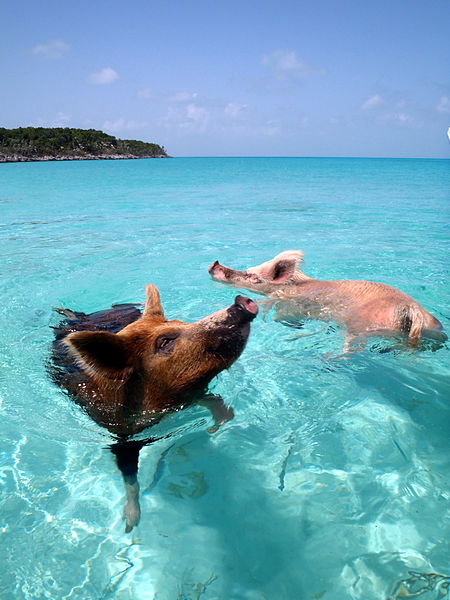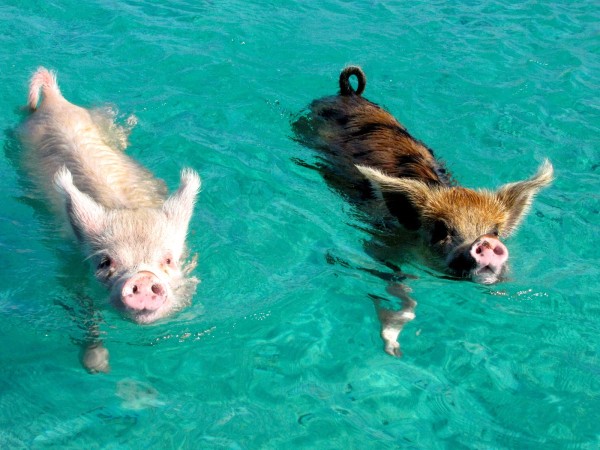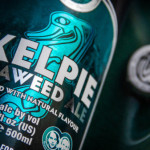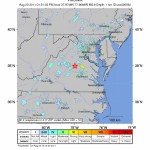 On a largely uninhabited island (a cay) in Bahamas, the chief residents are less than a two-dozen feral pigs. The island is now more lovingly referred to as Pig Island. The origins of these island pigs are unknown. One story suggests hungry sailors dropped them off to fatten them up for a later feast only to forget about them. Another legends claims they are the only survivors of a shipwreck. Or perhaps the island pigs were a business scheme to attract tourists to a nearby resort at Staniel Cay.
On a largely uninhabited island (a cay) in Bahamas, the chief residents are less than a two-dozen feral pigs. The island is now more lovingly referred to as Pig Island. The origins of these island pigs are unknown. One story suggests hungry sailors dropped them off to fatten them up for a later feast only to forget about them. Another legends claims they are the only survivors of a shipwreck. Or perhaps the island pigs were a business scheme to attract tourists to a nearby resort at Staniel Cay.
 By day the pigs take to the water, swimming in the clear Bahamian seas in search for food. However, do not get the wrong idea. These swimming swine are not top ocean predators on the look out for a reef fish. No they are looking for a handout from the tourists who are attracted to the island to see the paddling pigs. Price for admission? Food scraps. The pigs will run into the water from the nearby trees and swim out to oncoming boats for great tourists and collect their food fee.
By day the pigs take to the water, swimming in the clear Bahamian seas in search for food. However, do not get the wrong idea. These swimming swine are not top ocean predators on the look out for a reef fish. No they are looking for a handout from the tourists who are attracted to the island to see the paddling pigs. Price for admission? Food scraps. The pigs will run into the water from the nearby trees and swim out to oncoming boats for great tourists and collect their food fee.
Indeed, the island itself is a perfect spot for the playful porcine. A natural spring occurs on the island and string of neighboring islands largely protects it against storms. And with the islands lack of predators, theses pigs are nobody’s bathing bacon.
 The swimming pigs are feral domesticated pigs, Sus scorfa domesticus, introduced to the islands about two decades ago. From photographs, the swimming pigs appear smaller than typical pigs. Larger mammals over evolutionary time on islands tend toward smaller sizes, i.e. miniaturization. While small mammals tend toward larger sizes, i.e. gigantism. Work I published earlier this year with collaborators on this island rule indicate that there is no single smoking gun that causes these bizarre evolutionary routes in body size. The history of the species like where it came from, whether it’s a predator or herbivore, the climate of the island, and the presence of predators and competitors all likely impact the relationship. Are these diminutive pigs experiencing my beloved island rule? Or is simply tourism for skinny-dipping sows not a growth industry?
The swimming pigs are feral domesticated pigs, Sus scorfa domesticus, introduced to the islands about two decades ago. From photographs, the swimming pigs appear smaller than typical pigs. Larger mammals over evolutionary time on islands tend toward smaller sizes, i.e. miniaturization. While small mammals tend toward larger sizes, i.e. gigantism. Work I published earlier this year with collaborators on this island rule indicate that there is no single smoking gun that causes these bizarre evolutionary routes in body size. The history of the species like where it came from, whether it’s a predator or herbivore, the climate of the island, and the presence of predators and competitors all likely impact the relationship. Are these diminutive pigs experiencing my beloved island rule? Or is simply tourism for skinny-dipping sows not a growth industry?
And if you can’t enough of these adorable bastards then here is a whole gallery.







These pigs must’ve gotten a lot friendlier…
I was at pig beach about 13 years ago (I was 12), we didn’t know about the pigs at the time and just thought it was a nice looking beach and a decent place to anchor.
Those pigs came screaming at us from the bushes and they weren’t looking for treats. Unless my dad and I were the treats. We jumped back in the dingy and took off. They chased us well offshore.
Stupid jerk pigs.
Wow. A friend just experienced this firsthand. Here’s a question: with that small population, is there a danger that the gene pool (yes, I said pool, har har) will become dangerous to the population continuing?
It was all fun and games until the feral pigs developed a taste for the high protein content of human flesh. At first, the authorities passed off the reports of missing tourists as hearsay. But the island pigs were being subjected to the relentless mechanics of evolution, and were rapidly being selected for the one trait once exploited with merciless effect by their human counterparts: intelligence. Becoming ever more adept at throwing up the facade of friendly pigs during the daytime boat visits, the islanders would plan their night time ambushes on the late night boats – but only those with three or fewer human meals in them.
Over time, the pigs learned that puncturing the hulls of boats in deeper water and capsizing them would allow them to feast on the exhausted occupants therein with considerable ease, once they had made it to the shore. The personal belongings of the tourists on the boats were also saved from corrosion at the bottom of the sea. Cameras, backpacks, laptop computers, and the most important asset of all: batteries of many different types; were salvaged and brought ashore for inspection and evaluation. The pigs soon became seafarers in their own right, constructing rigid-hulled boats and stealthily colonizing the nearby uninhabited islands. Soon, democratic elections were held, and the first supreme dictator of the free pig nation was sworn in. A four-year old sow named Hheeuck-Jaaa Hwweeik was elected, and her first act in office was to immediately declare war on all human beings. Although the original generation of free pigs had all but passed away, their stories of the cruelty and torment inflicted upon them during captivity by their human overseers had been passed on to a younger and fiercer generations of swine.
The humans attacked first, after bones were found on an island and police investigators mauled. But their nerve agent-laden Cessnas, which had been tested on domestic pigs, were relatively ineffective on the island pigs, who had developed advanced immune systems and an extensive network of underground tunnels in which to hide.
The first wave of coordinated counterattack on the human race was unfathomably more swift and complex than had ever been expected. Two days after the first nerve agent attack, three quarters of the world went offline overnight, due to a single encrypted attack traced to a weak wi-fi connection in the Bahamas. Thousands of servers went back online the following day, but extraordinary chaos ensued. Traffic lights caused massive accidents, subway systems were paralysed and nuclear reactors went critical. Soon, SwineNet had silenced all major news broadcasts and a single feed was beamed to the world. A single pig, with alluringly piercing eyes and wearing what appeared to be kevlar armour, appeared onscreen and an eerily calm computerized English voice could be heard through a computer synthesizer “We are Pig Nation. Surrender or be annihilated.”